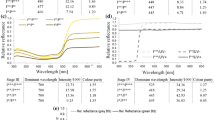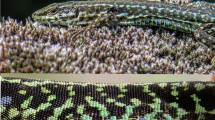Summary
In spontaneous-choice experiments on the butterfliesAglais urticae L. (Nymphalidae) andPararge aegeria L. (Satyridae) the spectral effectiveness and spectral sensitivity of various behaviors were investigated and compared.
Pilot experiments with colored PVC films showed indications of an intensity dependence of the feeding reaction inP. aegeria. Moreover, they revealed a color discrimination independent of this intensity discrimination:P. aegeria distinguishes red from grey shades as well as from black and white (Fig. 3).
According to subsequent spontaneous-choice experiments using monochromatic light stimuli, the various visually controlled functional categories of behavior can be assigned to the following spectral regions: 1. The open-space reaction corresponds to the UV and violet region, ca. 320–420 nm, inP. aegeria (Figs. 4, 7). 2. The feeding reaction corresponds to the blue region, ca. 420–500 nm, inA. urticae (Fig. 1) andP. aegeria (Fig. 4), and the yellow region, ca. 550–590 nm, inA. urticae (Fig. 1) and the orange-red region, ca. 570–670 nm, inP. aegeria (Fig. 4).
In these experiments with monochromatic light stimuli the intensity dependence of the reactions is also obvious (Figs. 2, 5, 6).
The open-space reaction is elicited inP. aegeria by white light dependent on its UV content (Fig. 8). This is also valid for the feeding reaction inP. aegeria (Fig. 5b). To elicit this reaction it was necessary to offer light stimuli simultaneously with the odour stimulus of honey water. As the latter was of the same quality in combination with all light stimuli the results can be attributed definitely to the different effectiveness of the various light stimuli.
Pure wavelength-specific behavior can be ruled out inA. urticae andP. aegeria. Wavelength-specific behavior and color vision are probably present simultaneously.
Similar content being viewed by others
Abbreviations
- RNQ:
-
relative number of quanta
References
Alaibak A (1981) Verhaltensversuche zur Farbpräferenz vonAglais urticae L. (Lepidoptera). Diplomarbeit, Universität München
Autrum H, Thomas I (1973) Comparative physiology of colour vision in animals. In: Jung R (ed) Central processing of visual information (Handbook of sensory physiology, vol VII/3A). Springer, Berlin Heidelberg New York, pp 661–692
Autrum H, Zwehl V von (1964) Spektrale Empfindlichkeit einzelner Sehzellen des Bienenauges. Z Vergl Physiol 48:357–384
Bernard GD (1979) Red-absorbing visual pigment of butterflies. Science 203:1125–1127
Bernard GD (1983) Bleaching of rhabdoms in eyes of intact butterflies. Science 219:69–71
Bowmaker JK, Dartnall HJA (1980) Visual pigments of rods and cones in a human retina. J Physiol 298:501–511
Brown PK, Wald G (1964) Visual pigments in single rods and cones of the human retina. Science 144:45–51
Burkhardt D (1983) Wavelength perception and colour vision. In: Cosens DJ, Vince-Price D (eds) The biology of photoreception. Cambridge University Press, Cambridge, pp 371–397
Eguchi E, Watanabe K, Hariyama T, Yamamoto G (1982) A comparison of electrophysiologically determined spectral responses in 35 species of Lepidoptera. J Insect Physiol 28:675–682
Gemperlein R (1980) Fourier Interferometric Stimulation (FIS). A new method for the analysis of spectral processing in visual systems. MEDINFO 80, IFI P, North Holland Publishing Company, Tokyo, pp 372–376
Gemperlein R (1982) The determination of spectral sensitivities by Fourier Interferometric Stimulation (FIS). The basic principles and advantages. Doc Ophthalmol Proc Ser 31:23–29
Horridge GA, Marcelja L, Jahnke R, Matić T (1983) Singleelectrode studies on the retina of the butterflyPapilio. J Comp Physiol A 150:271–294
Horridge GA, Marcelja L, Jahnke R (1984) Colour vision in butterflies. I. Single colour experiments. J Comp Physiol A 155:529–542
Ingle D (1985) The goldfish is a retinex animal. Science 227:651–654
Kolb G (1985) Ultrastructure and adaptation in the retina ofAglais urticae (Lepidoptera). Zoomorphology 105:90–98
Kolb G, Scholz W (1985) Ultraviolett-Reflexionen und Sexualdimorphismus bei Tagfaltern. Mitt Dtsch Ges Allg Angew Entomol 4:184–187
Land EH (1977) The retinex theory of color vision. Sci Am 237: 6 108–128
Land EH (1986) Recent advances in retinex theory. Vision Res 26:7–21
Menzel R (1977) Farbensehen bei Insekten —ein rezeptorphysiologischer Problemkreis. Verh Dtsch Zool Ges 70: 26–40
Menzel R (1979) Spectral sensitivity and color vision in invertebrates. In: Autrum H (ed) Vision in invertebrates (Handbook of sensory physiology, vol VII/6A. Springer, Heidelberg New York Berlin, pp 503–580
Paul R (1981) Neue Aspekte der spektralen Empfindlichkeit vonCalliphora erythrocephala gewonnen durch Fourier-interferometrische Stimulation (FIS). Dissertation, Universität München
Paul R, Steiner A, Gemperlein R (1986) Spectral sensitivity ofCalliphora erythrocephala and other insect species studied with Fourier Interferometric Stimulation (FIS). J Comp Physiol A 158:669–680
Rushton WAH (1972) Pigments and signals in colour vision. J Physiol 220:1P-31P
Scherer C, Kolb G (1987) Behavioral experiments on the visual processing of color stimuli inPieris brassicae L. (Lepidoptera). J Comp Physiol A 160:645–656
Schümperli RA (1975) Monocular and binocular visual fields of butterfly interneurons in response to white and coloured light stimulation. J Comp Physiol 103:273–289
Steiner A (1982) Fourierinterferometrische Messung der spektralen Empfindlichkeit von zwei Schmetterlingsarten (Pierisbrassicae undAglais urticae). Wissensch Ausstellung, Neurobiologentagung, Göttingen
Steiner A (1984) Die lineare und nichtlineare Analyse biologischer Sehsysteme mit einfachen Sinusreizen und FourierInterferometrischer Stimulation (FIS). Dissertation, Universität München
Steiner A, Paul R, Gemperlein R (1987) Retinal receptor types inAglais urticae andPieris brassicae (Lepidoptera), revealed by analysis of the electroretinogram obtained with Fourier interferometric stimulation (FIS). J Comp Physiol A 160:247–258
Swihart SL (1969) Colour vision and the physiology of the superposition eye of a butterfly (Hesperiidae). J Insect Physiol 15:1347–1365
Swihart SL (1970) The neural basis of colour vision in the butterflyPapilio troilus. J Insect Physiol 16:1623–1636
Swihart SL (1972a) The neural basis of colour vision in the butterflyHeliconius erato. J Insect Physiol 18:1015–1025
Swihart SL (1972b) Modelling the butterfly visual pathway. J Insect Physiol 18:1915–1928
Tinbergen N, Meeuse FJD, Boerema LK, Variosseau WW (1943) Die Balz des Samtfalters,Eumenis (= Satyrus) semele (L.). Z Tierpsychol 5:182–226
Author information
Authors and Affiliations
Additional information
Supported by the Deutsche Forschungsgemeinschaft Ko 445/5-3
Rights and permissions
About this article
Cite this article
Scherer, C., Kolb, G. The influence of color stimuli on visually controlled behavior inAglais urticae L. andPararge aegeria L. (Lepidoptera). J. Comp. Physiol. 161, 891–898 (1987). https://doi.org/10.1007/BF00610230
Accepted:
Issue Date:
DOI: https://doi.org/10.1007/BF00610230




